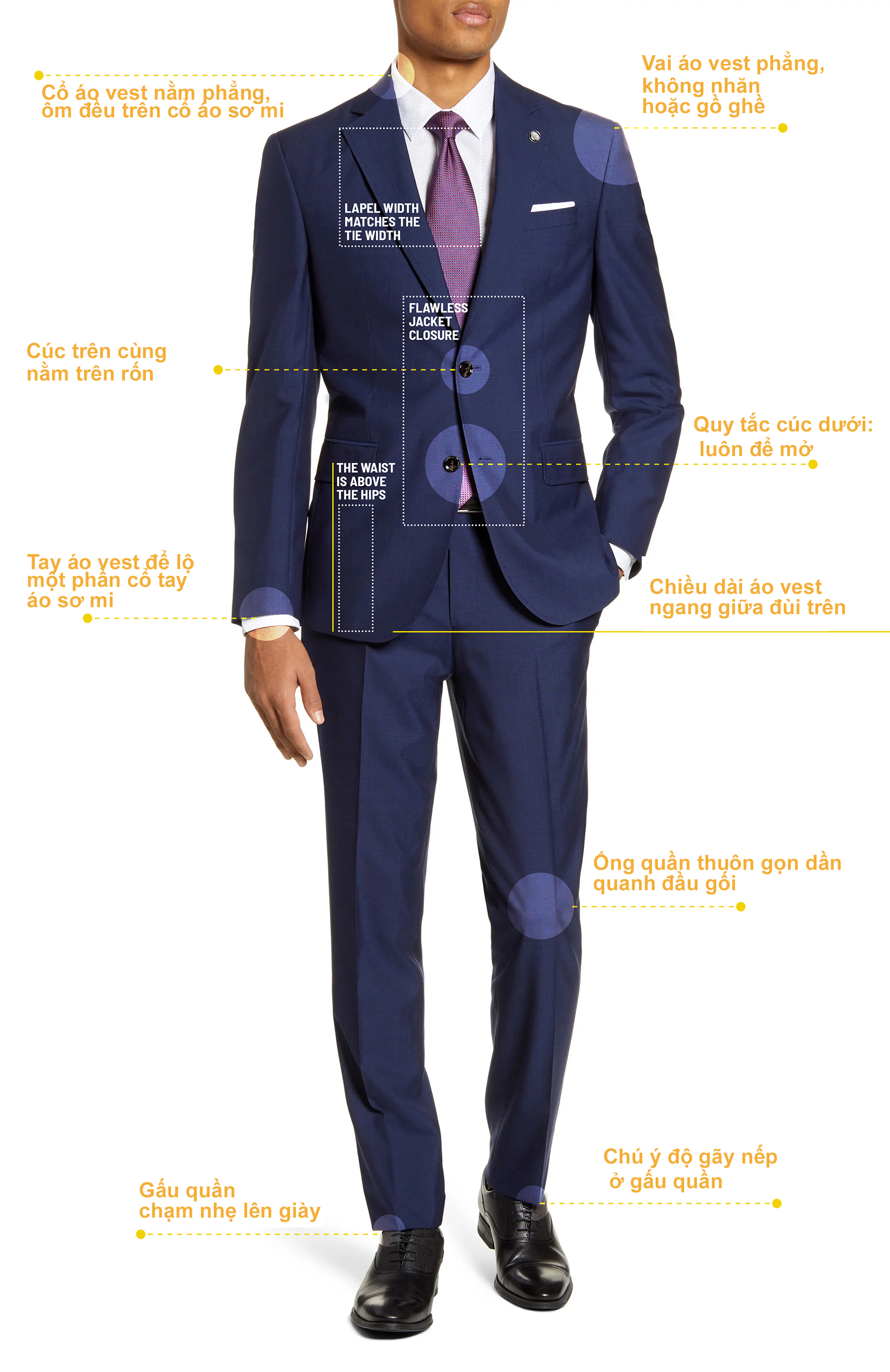
How to Wear a Suit Properly? The Gentleman’s Guide
Share
1. Why Does Wearing a Suit Properly Matter?
A suit has long been a symbol of elegance, confidence, and status for men. Whether at work, weddings, galas, or important events, a suit is always the go-to outfit for making a statement. But wearing a suit isn’t just about putting on a jacket and trousers. Without knowing the rules, it’s easy to make mistakes that compromise your look.

-
Suit: A set that includes a jacket and trousers, and sometimes a vest, making it a three-piece suit.

Popular Suit Styles:
-
Single-breasted: One row of buttons (usually 2 or 3). The most versatile and common style.
-
Double-breasted: Two rows of buttons, giving a stronger, more classic and authoritative look.
-
Two-piece suit: Jacket + trousers; ideal for work, casual events, and semi-formal gatherings.
-
Three-piece suit: Jacket + trousers + vest; best for weddings or formal occasions.
Understanding the difference ensures you always choose the right suit for the right setting.
3. Essential Rules of Wearing a Suit

3.1 Fit – The #1 Priority
The key to a great suit is fit, not price. A well-fitted suit should complement your body shape while keeping you comfortable.
-
Shoulders: Seams must align exactly with your natural shoulders.
-
Sleeves: Jacket sleeves should reveal 1–2 cm (½–¾ inch) of your shirt cuff.
-
Jacket length: The hem should cover your seat and fall around mid-thigh.
-
Trousers: Should touch the top of your shoes with a slight break. Shorter men should avoid excess breaks for a taller appearance.
3.2 Button Rules
-
Two-button suit: Always fasten the top button, never the bottom.
-
Three-button suit: Fasten the middle (and optionally the top), never the bottom.
-
Double-breasted suit: Keep all functional buttons fastened.

3.3 Lapels & Tie Etiquette
-
Lapel width should match your shoulder build – broader shoulders call for wider lapels.
-
A tie should end exactly at your beltline, never too short or too long.
4. Choosing the Right Suit for Your Body Type
Not every suit fits every man equally well. The right cut can hide flaws and enhance strengths.
-
Tall & Slim: Opt for double-breasted suits, checks, or horizontal stripes. Wider lapels add balance.
-
Shorter Men: Go for single-breasted suits with slim lapels. Vertical stripes or solid colors help elongate the frame. High-waisted trousers also make legs appear longer.
-
Broad/Bigger Builds: Darker shades (black, navy, charcoal) slim the silhouette. Stick to single-breasted styles. Avoid large checks or horizontal stripes.
5. Shoes & Accessories – Perfecting the Gentleman’s Look
-
Shoes: Oxford, Derby, or Monk Strap shoes are timeless classics. Always match shoe color with your belt.
-
Belts: Slim, understated buckles. Leather color must match your shoes.
-
Watches: A sleek dress watch with a leather or thin metal strap is ideal. Coordinate metal tones with other accessories.

-
Pocket Squares: Should contrast subtly with your tie, not match exactly (e.g., navy suit + gray tie + white pocket square).

-
Socks: Long enough to cover your ankles when seated. Stick to neutral colors or add discreet patterns for flair.
6. Dressing for Different Occasions
-
Office Wear: Navy or charcoal wool suits – versatile, breathable, professional year-round.
-
Weddings: Opt for dark blue, light gray, or light brown suits. Add a pocket square for flair. Avoid black unless it’s a formal evening wedding.
-
Formal Events / Galas: Black suits are the safest choice, paired with a black tie or bow tie. Here, highlight the difference between a standard black suit and a tuxedo.

7. Common Suit Mistakes Men Make
-
Fastening the bottom button – ruins the suit’s silhouette.
-
Not unbuttoning the jacket when sitting – causes bulging.
-
Wearing jackets too long or too short – ideal length is mid-seat.
-
Incorrect sleeve length – should show a touch of shirt cuff.
-
Trousers too long or too short – aim for a light break.
-
Wrong shoe pairing – e.g., black shoes with a navy suit (brown is better).
-
Cheap-looking fabrics – shiny polyester looks low quality; wool or linen feels elegant and breathable.
Conclusion
Wearing a suit is not just about clothing – it’s an art of presence, confidence, and refined taste. Once you master the basics – fit, lapels, button rules, accessories – your suit becomes a powerful tool to stand out at any occasion.
A well-fitted suit enhances not only your look but also your personal brand.
Ready to elevate your style with the perfect suit? Visit Harold.vn to explore finely tailored suits, premium fabrics, and expert styling advice.
Don’t just wear a suit – wear confidence and class.



